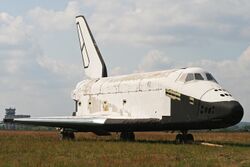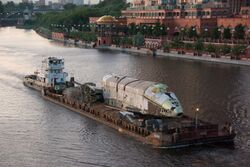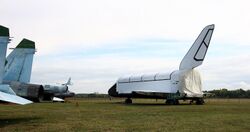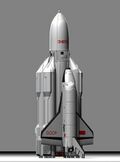Engineering:2.01 (Buran-class spacecraft)
 Buran 2.01 (2012) | |
| Country | Soviet Union |
|---|---|
| Contract award | 1983 |
| Status | unfinished |
| Days spent in space | None |
2.01 (GRAU index serial number 11F35 3K) is the designation of the third space shuttle to be produced as part of the Soviet/Russian Buran program. Its construction was not complete when the Buran program was cancelled (30–50 percent done), so it remains unfinished.[1] It was never officially named.
Differences from Buran and 1.02
The 2.01 is the first of a second series of Buran-class shuttle orbiters. Design has been improved using feedback from the earlier models of Buran-class shuttles, such as the flight of Buran and the construction of 1.02.[1]
Major changes include:
- Hull design optimized to save weight.
- Thermal protection system arrangement changed.
- Spoilers added to elevons.
- OMS thrusters configuration changed.
- Payload bay doors radiator design simplified.
- Landing gear improved.
- Drag chute container was reduced, since it turned out the surface area of the parachutes in the flight of Buran was overabundant.
After Challenger disaster it was decided to limit crew capacity of second series orbiters to four crew-members with ejection seats regularly mounted.[2]
Since none of second series orbiters were completed, only changes in thermal protection system and OMS thrusters arrangement can be visible on 2.01.
History
Projected flights
It was projected in 1989 that orbiter 2.01 would have its first manned space test flight, 3K1, in 1994, with a duration of twenty-four hours. The craft would have been equipped with a life support system and two ejection seats. Crew would have consisted of two cosmonauts — Igor Volk (commander) and Aleksandr Ivanchenko (flight engineer).[3]
In 1991, construction of the orbiter was suspended, and in 1993, the Buran program was completely cancelled.
Post-retirement
After residing at the Tushino factory where it was constructed, it was incorrectly announced in 2006 that orbiter 2.01 would be put on display in the Sinsheim Auto & Technik Museum, Germany . However, the German Museum had actually bought OK-GLI, the jet-powered Buran atmospheric test vehicle, which appeared on display in its own new hangar from September 2008.[1]
Since 2004 the orbiter 2.01 had been left under open sky on a car park in Moscow, near Khimki Reservoir.[4][5][6][7][8]
On 22 June 2011, during the day the orbiter was put on a barge[9] to be moved to the MAKS 2011 international air show, which took place from 16 to 21 August in Zhukovsky (Moscow region).[10] In the night of 22–23 June, it was seen on the Moskva River.[11][12] The orbiter was exposed at the show with one side restored.
In 2012, it was seen during the Russian Air Force 100th Anniversary Airshow in Zhukovsky.
It was expected that it would be restored in Zhukovsky and shown at the MAKS 2013 exhibition, but it never appeared at the exhibition. (As of November 2013), it remained at the Zhukovsky International Airport ( [ ⚑ ] 55°33′06″N 38°08′40″E / 55.5517°N 38.1444°E).[13]
In July 2017, heat-tiles from orbiter 2.01 were listed online, leading some to believe that the orbiter had been scrapped or otherwise disassembled.[14] However, satellite imagery of Zhukovsky Airport taken in 2019 indicates that 2.01 still resides at the airfield, albeit now in a different location.[15]
See also
- Mikoyan-Gurevich MiG-105 — Soviet orbital spaceplane
- Spaceplane
- Spacecraft
References
- ↑ 1.0 1.1 1.2 "Shuttle Buran 2.01 current status". http://www.k26.com/buran/Future/2.01/space_buran_2_01.html. Retrieved 2006-08-05.
- ↑ http://www.buran.ru/galapago/NK2018-12_buran.pdf (in Russian)
- ↑ "Error: no
|title=specified when using {{Cite web}}" (in ru). buran.ru. http://www.buran.ru/htm/pilots.htm. Retrieved 2006-08-05. - ↑ "Where Do Shuttles Go?". English Russia. 2008-07-30. http://englishrussia.com/2008/07/30/where-do-shuttles-go/. Retrieved 2011-08-20.
- ↑ Moscow (1970-01-01). "moscow - Google Maps". Google Maps. https://maps.google.com/maps?q=moscow&ie=UTF8&t=k&om=0&hl=en&ll=55.841374,37.466115&spn=0.001422,0.003455&z=18&hl=en. Retrieved 2011-08-20.
- ↑ "Тушинский машиностроительный завод, на котором строился космический челнок "Буран", открестился от своего детища". 5-tv.ru. 2010-09-30. http://www.5-tv.ru/news/33014/. Retrieved 2011-08-20.
- ↑ Автор: Дмитрий Мельников (2010-09-28). "Вести.Ru: "Буран" остался без крыльев и хвоста". Vesti.ru. http://www.vesti.ru/doc.html?id=395709. Retrieved 2011-08-20.
- ↑ "Photo". Archived from the original on 2014-03-16. https://web.archive.org/web/20140316152452/https://ssl.panoramio.com/photo/38956919. Retrieved 2013-09-13.
- ↑ http://www.buran-energia.com/blog/wp-content/uploads/2011/06/5859100207_bacdfeb4f3.jpg
- ↑ "Buran-Energia Buran OK-2.01". Buran-energia.com. http://www.buran-energia.com/blog/category/bourane/buran-OK-201/lang-pref/en/. Retrieved 2011-08-20.
- ↑ https://www.tagesschau.de/multimedia/bilder/buran102_v-grossgalerie16x9.jpg
- ↑ "7289 – Проект 942 — Водный транспорт". Fleetphoto.ru. http://fleetphoto.ru/ship/4656/. Retrieved 2011-08-20.
- ↑ Russian Space Agency VKK Buran 2.01: Photo dated 27 November 2013.
- ↑ "Buran Space Shuttle Shop - Buran's tile". http://www.buran-energia.com/boutique-shop/product_info.php?products_id=36.
- ↑ "55°34'16.3"N 38°08'34.5"E" (in en). https://www.google.com/maps/place/55%C2%B034%2716.3%22N+38%C2%B008%2734.5%22E/@55.5711944,38.1423695,101m/data=!3m2!1e3!4b1!4m6!3m5!1s0x0:0x0!7e2!8m2!3d55.5712056!4d38.1429271.
External links
- 2.01 orbiter
- 2.01 status incorrectly mentioning its relocation to Germany
- Images of 2.01 parked open air in Moscow in 2004 with a notice it's being moved to NPO Molniya





